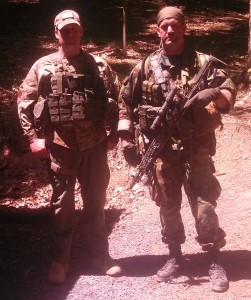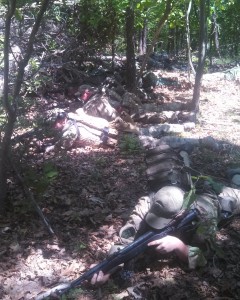24-26 May Patrol Class + Night Movement Tips
Above Max (MVT) & JC (MDT) at this weekend’s Combat Patrol Class
I’m just back at my computer after this past weekend’s Combat Patrol Class. On this class, night movement posed more of a challenge, specifically for the night reconnaissance patrol portion of the tactical exercise.
The background to this is that there was a starlit cloudless sky but no moon. This made it very dark, in particular under the canopy. Night time light conditions can vary from so bright the moon casts shadows and it feels like daytime, to where you can’t see your hand in front of your face. Because of the summer sunset times, the recce patrol started in daylight and transitioned into darkness. In general, the teams did very well and managed to traverse some difficult terrain in the darkness. I had given them permission to use the trails on the way back in case going was tough on the steep wooded terrain and visibility was very bad. Although not the most tactically sound practice, there is a convergence of tactics and safety, and the primary training objective was the conduct of a close target recce patrol at night. It was a compromise between safety and tactical considerations.
In this post I want to throw out some movement tips for nighttime, primarily focused on ‘old school’ considerations for when you don’t have modern night optic devices. I wrote a previous post titled ‘Considerations for Night Operations‘ which would prove a useful companion read to this one .
Note also that on the night optical device side, I have started a new class specifically for this: Night Optical Device Firing (NODF).
So in no particular order:
- At night with the naked eye, due to the dispersion of rods and cones on the back of the eye, when trying to see something at night, don’t stare at it, but look off to the side. You will see it better.
- Don’t be reliant on technology as a comfort blanket, particularly if you don’t know how to use it. I was using my PVS14’s to both walk about and observe, and drive my Ranger ATV around the woods. The two students who had PVS14s claimed to not be able to see with the devices. If I had known about this in advance I could most likely have twiddled a couple of knobs and adjusted the focus and brightness so they would have been able to see. It’s not good enough to just spend money. Know your gear. Get suitable training. Yes, PVS14’s are image intensifiers so they are not as good in lower light than when there is more moonlight, but you can still see an awful lot. Enough to patrol around with and observe.
- Natural night vision is very effective. It needs time (30-45 minutes) to develop and needs to be carefully guarded. Use red or green pen lights to read maps, so you don’t lose night vision. If subjected to flares or headlights, when taking cover close your eyes and keep your head down. At minimum, close one eye, the same one every time, and observe with the other if you need to. Similarly, if using NODs (Night Observation Devices), keep it to one eye (The non-dominant eye for PVS14 style monoculars) and preserve the night vision in the other eye.
- If not practiced, moving about at night is an unnatural activity. It is outside of your usual comfort zone, and can lead to loss of confidence and fear/panic. On a very dark night you may not really be able to see at all, particularly in the woods, and thus you have lost that sense. You still have hearing and touch.
- Sight: even if you can’t see much, you have to use what you can see. You may be able to see the tree tops against the night sky. If you are on a trail, you may be able to see the lighter ribbon of the trail between the darker canyon of the trees. You will see the loom of terrain, the shoulder of the ridge, or similar. You won’t be able to see the ground very well but you have to walk with confidence and put your feet down with a little care.
- You will see the loom of the person in front and you have to close up enough so that you don’t lose them. Cat eyes can help but again don’t rely on technology.
- A lot of problems come from people trying to move at daytime speeds and not realizing that you need to slow down at night. Put your feet down more carefully.
- Touch: You will feel if you are going up or down hill. The type of ground you are walking on. Gravel or leaves? If you are moving through a wood, you may have to slow down and even grasp the harness or shoulder of the man in front. You may be feeling your way sightlessly through the wood. The point man will have one hand on his weapon and the other feeling up and down out in front of his face. You may even close your eyes and look away, to protect your face, as you slowly feel your way through the trees.
- Feel the ground as you are stepping, before shifting weight from the rear to the front foot. Feel any twigs that you may break. If you move slowly, if your leg goes into something like a branch across the trail, you will feel it rather than bang into it, and you can then crouch down, feel it, and step over it.
- If trying to move stealthily, step forwards with your foot pointed. Slowly put the outside of the front of your boot on the ground and roll into back to the outside of the heel, before rolling the sole fully onto the ground. This way you transfer weight slowly and will feel if you are going to break any twigs, rustle leaves, or knock a rock against another.
- You need to moderate your pace to the visibility, what is underfoot, and to the degree of stealth that you need to achieve.
- Put in frequent listening halts, both at planned rally points and ad hoc. Stop, get down, and wait silently. Closing your eyes and opening your mouth helps.
- Hand signals are ideal for patrols. If it is too dark you won’t be able to see hand signals, and you will be closer together. This is why a good brief and rehearsals are vital. You can do hand signals, such as the circular signal for a rally point, on the palm of your buddies hand. If a plan changes or information needs to be put across, you often have no choice but to whisper quietly into each man’s ear.
Above: Practicing breaking track and putting in a hasty ambush on the Patrol Class, as part of the occupation of the patrol base.
- If you have no night vision equipment, and the enemy does, then this may negate any advantage that you have for operating at night. Then you may make a decision to operate during the day using camouflage and concealment, terrain masking etc. However, night vision is not perfect and if you have good fieldcraft, and there is decent visibility with at least a partial moon and cloudless sky, you may be able to operate effectively at night while retaining some of the advantages that the cloak of darkness gives you.
- If the enemy has night vision capability, you need to operate at night just as you do during the day. This means using camouflage and concealment, terrain masking, and acting at all times as if you are under observation. The problem here is that you need to spread out to daytime patrol spacing, but you may not be able to do that if you have no night vision and it is a very dark night. In such a case, plan operations when you have sufficient visibility to spread out, or go for daylight options.
- Night vision monoculars are best used head mounted so that they can provide scanning observation as you move on patrol. However, to be used for targeting you need to interface the PVS14 with your rifle, by using a weapon mounted IR laser. IR NODs are not however a magic pill. You enter a strange world where you lose a little depth perception, and you have to train and spend time doing this. You also cannot see any better than during the day (worse) and you are forcing your brain to interpret the images. If they can hide from you in daylight, they can hide from you at night.
- Handheld thermal imaging, such as the FLIR Scout, is a game changer and a lifesaver. Again, it’s not a magic bullet, and you still have to scan and observe, but you can use them both day and night to scan an area for threats. The FLIR Scout has a setting where it will not only do a black hot or white hot screen, but on the white hot screen it has 4 settings where it will color any strong heat sources in red. This immediately highlights things on a scan. A vehicle engine that has been turned off but was running will show up as red. People and animals will show up as red. So you can pick people out of the background as you scan.
The primary take away is that patrol movement at night is outside the comfort zone of most people and needs to be trained and practiced.
I am putting a couple of classic British Army training videos in this post. It looks like they are from the 80’s. These are well worth your time: everything in these videos is valid, and it shows the preparation and conduct of a recce patrol. Usefully, they do have some older generation night vision and thermal gear, so you see a little of the use of old-school techniques, as well as technology.
(RV = Brit Army for rally point)
Don’t forget your sandbag!
Recce Patrol Part 1:
Recce Patrol Part 2;
EDIT: Check out JRH Enterprises for night vision gear. Also, here is some gear porn: FLIR Thermosight RS24.
Live Hard.
Die Free.
Max


